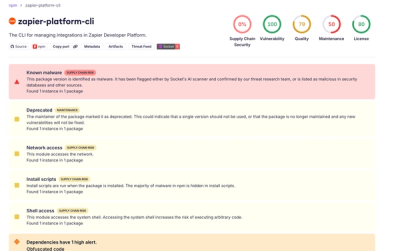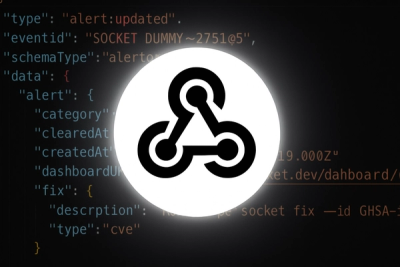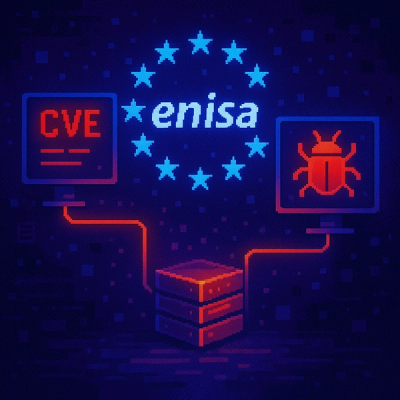
Research
/Security News
Shai Hulud Strikes Again (v2)
Another wave of Shai-Hulud campaign has hit npm with more than 500 packages and 700+ versions affected.
@burst/imagekit
Advanced tools
The ultimate, lightweight solution for using ImageKit images in a JavaScript project.
This module provides an <ImagekitImage /> component that automates the optimization of images.
If you have a full-width (100vw) image, then it's very easy to create a dynamic image.
import { ImagekitImage } from '@burst/imagekit';
<ImagekitImage
src="https://ik.imagekit.io/demo/medium_cafe_B1iTdD0C.jpg"
breakpoints={[240, 600, 1000]}
aspectRatio={16 / 9}
/>;
This will let the browser choose between a 240px, 600px and 1000px image. If you would view this image on a screen of 500px with a retina screen (device pixel ratio of 2) then it would show the 1000px version.
This logic is fine for most full-width or almost-full-width images.
If you have an image where the aspect ratio is always the same, but the width can differ between viewports, you can use the default html sizes tag to differ between images.
import { ImagekitImage } from '@burst/imagekit';
<ImagekitImage
src="https://ik.imagekit.io/demo/medium_cafe_B1iTdD0C.jpg"
breakpoints={[240, 600, 1000]}
aspectRatio={16 / 9}
sizes="(min-width: 800px) 50vw, 100vw"
/>;
Another option is to implement this into the breakpoints array. Instead of providing a simple number, you can provide a tuple. The first item will be the window width, the second item is the size you expect the image to be in until that breakpoint.
import { ImagekitImage } from '@burst/imagekit';
<ImagekitImage
src="https://ik.imagekit.io/demo/medium_cafe_B1iTdD0C.jpg"
breakpoints={[200, [600, 300], [1000, 500], 700]}
aspectRatio={16 / 9}
/>;
This results in the following behaviour:
| Window size | Image size |
|---|---|
| 0px - 200px | 200px |
| 201px - 600px | 300px |
| 601px - 1000px | 500px |
| 1001px + | 700px |
The following component would render exactly the same result:
import { ImagekitImage } from '@burst/imagekit';
<ImagekitImage
src="https://ik.imagekit.io/demo/medium_cafe_B1iTdD0C.jpg"
breakpoints={[200, 300, 500, 700]}
aspectRatio={16 / 9}
sizes={`
(min-width: 1001px) 700px,
(min-width: 601px) 500px,
(min-width: 201px) 300px,
200px
`}
/>;
If the aspect ratio is not the same between all breakpoints, you can define a width and aspect ratio for the breakpoints that are different.
For example, to render a 1:1 aspect ratio from 0 - 600px and a 16:9 aspect ratio from 601px and more, you would use this:
import { ImagekitImage } from '@burst/imagekit';
<ImagekitImage
src="https://ik.imagekit.io/demo/medium_cafe_B1iTdD0C.jpg"
breakpoints={[
[200, { ar: 1 / 1 }],
[600, { ar: 1 / 1, w: 300 }],
[1000, 500],
700,
]}
aspectRatio={16 / 9}
/>;
This would generate a picture element with two sources, one for the 1:1 version and one for the 16:9 version.
Whenever possible, this component will just render an <img> tag with the srcset and sizes attribute set. This is enough to let the browser choose the right version of an image intelligently. It will automatically take care of image caching (so, if it has a large image already cached, it will not download a lower-quality image) and will take care of the device image
If however the aspect ratio changes between breakpoints (for example, mobile images are always 1:1 and desktop images are always 1:2) it will use an <picture> element with <source> in it. This will force the browser to use the right aspect ratio at the right breakpoints.
For more information, check out these awesome resources:
<img> and <picture> elementThe createImagekitUrl() function can be used to generate URLs manually.
import { createImageUrl } from '@burst/imagekit';
const simpleUrl = createImageUrl({
src: 'https://ik.imagekit.io/demo/medium_cafe_B1iTdD0C.jpg',
transformations: {
w: 200,
ar: 16 / 9,
},
});
This will make 'simpleUrl' an image with a width of 200 pixels and an height of 113 pixels to maintain a 16:9 aspect ratio. In this case, it would return https://ik.imagekit.io/demo/medium_cafe_B1iTdD0C.jpg?tr=w-200,h-113.
For more examples, check out the tests created for this function.
This module has been fully optimized for using images with a focal point provided by the Drupal focal_point module.
For this, the right information should be passed into the src argument of the <ImagekitImage /> or the createImageUrl().
FAQs
Burst package that contains all reusable react components
The npm package @burst/imagekit receives a total of 1 weekly downloads. As such, @burst/imagekit popularity was classified as not popular.
We found that @burst/imagekit demonstrated a not healthy version release cadence and project activity because the last version was released a year ago. It has 7 open source maintainers collaborating on the project.
Did you know?

Socket for GitHub automatically highlights issues in each pull request and monitors the health of all your open source dependencies. Discover the contents of your packages and block harmful activity before you install or update your dependencies.

Research
/Security News
Another wave of Shai-Hulud campaign has hit npm with more than 500 packages and 700+ versions affected.

Product
Add real-time Socket webhook events to your workflows to automatically receive software supply chain alert changes in real time.

Security News
ENISA has become a CVE Program Root, giving the EU a central authority for coordinating vulnerability reporting, disclosure, and cross-border response.